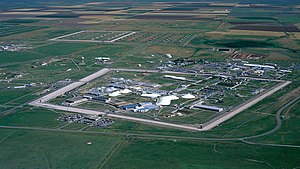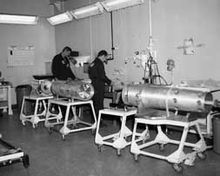Pantex

Pantex is the primary United States nuclear weapons assembly and disassembly facility that aims to maintain the safety, security and reliability of the U.S. nuclear weapons stockpile.[1][2] The facility is named for its location in the Panhandle of Texas on a 16,000-acre (25 sq mi; 65 km2) site 20 miles (32 km) northeast of Amarillo, in Carson County, Texas. The plant is managed and operated for the United States Department of Energy (DOE) by Consolidated Nuclear Security (CNS) and Sandia National Laboratories. CNS is composed of member companies Bechtel, Leidos, Orbital ATK, and SOC, with Booz Allen Hamilton as a teaming subcontractor.[3] CNS also operates the Y-12 National Security Complex in Tennessee, a manufacturing facility for nuclear weapons components.[3]
As a major national security site, the plant and its grounds are strictly controlled, and the airspace above and around the plant is prohibited to civilian air traffic by the FAA as Prohibited Area P-47.
History
[edit]

The Pantex plant was originally constructed as a conventional bomb plant for the United States Army Air Force during the early days of World War II. The Pantex Ordnance Plant was authorized February 24, 1942. Construction was completed on November 15, 1942 and workers from all over the U.S. flocked to Amarillo for jobs.
Pantex was abruptly deactivated when the war ended and remained vacant until 1949, when Texas Technological College in Lubbock (now Texas Tech University) purchased the site for $1.[4] Texas Tech used the land for experimental cattle-feeding operations.
In 1951, at the request of the Atomic Energy Commission (now the National Nuclear Security Administration (NNSA)), the Army exercised a recapture clause in the sale contract and reclaimed the main plant and 10,000 acres (40 km2) of surrounding land for use as a nuclear weapons production facility. The Atomic Energy Commission refurbished and expanded the plant at a cost of $25 million. The remaining 6,000 acres (24 km2) of the original site were leased from Texas Tech in 1989.
Pantex was operated by Procter & Gamble from 1951 to 1956, Mason & Hanger from 1956 to 2001, and Babcock & Wilcox from 2001 to 2014.[5]
In 2010, the plant employed about 3,600 people and had a budget of $600 million.[6]
Health and environmental concerns
[edit]
There has been perennial interest in whether conditions at the plant have led to health problems in its workers or the surrounding communities. In 1998, the Agency for Toxic Substances and Disease Registry documented a statistically significant incidence of increased cancer rates and low birth weights in some of the counties surrounding Pantex, but the counties closest to the plant (Armstrong and Carson) had no significant increase in cancer rates. The agency concluded that the plant was not likely to be associated with these findings.[4] A 2005 NIOSH study of cancer rates among Pantex workers over the timespan 1951–1995 found that they had a stastistically-significant increase in occurrence of prostate cancer and multiple myeloma with length of employment, leading the authors to recommend follow-up research to investigate whether the working conditions of those employees was the cause.[7] In 2013, the Amarillo Globe-News reported that some Pantex employees had been awarded financial compensation by the U.S. government after developing health problems that may have been related to depleted uranium or thorium exposure.[8]
In 1994, the EPA listed the plant as a Superfund site, having found toxic chemicals, including radionuclides, in over a hundred places in its soil and groundwater. This was due to improper waste management practices for the materials in question, like storing wastewater in unlined ponds, burying waste in unlined landfills, and burning waste in the open. Using techniques such as soil vapor extraction and bioremediation as well as changing institutional practices at the plant, the EPA oversaw a cleanup that they said made the site safe in the short term as of 2009, although their long-term cleanup of the site's perched groundwater is ongoing as of 2024.[9][10]
Public opposition
[edit]- In 1986 activists from the Red River Peace Network purchased 20 acres (81,000 m2) adjacent to Pantex to create the "Peace Farm", described as "a visible witness against weapons of mass destruction."[11] Its staff and board organized events, rallies, and gatherings opposing nuclear weapons through the 1990s and now organizes events related to the environment, nuclear proliferation and waste disposal, and peace issues.
- In the early 1980s, local Catholic Bishop Leroy Matthiesen tried persuading Catholic workers at the plant to leave their jobs, offering financial support to those who would do so.
Labor troubles
[edit]Labor troubles arose in 2007 following the implementation of stricter physical and performance requirements for armed security personnel following the September 11th attacks. The worker's union for the Pantex guards protested that the new standards were unfairly strenuous to middle-aged personnel nearing retirement.[12] In protest 500 guards walked off the job and went on strike in April 2007 and were replaced with a temporary guard force.[13] The strike ended with a negotiated settlement after 34 days. Guards also went on strike in a pay dispute in 1981, and unionized production and maintenance workers struck in 1970 and 2015.[14]
Safety incidents
[edit]- In 1977, three men were killed in an explosion while machining LX-09, a plastic explosive.[15]
- In 2005, the Project on Government Oversight (POGO) claimed that Pantex workers could have caused a nuclear explosion when they improperly applied too much pressure on an obsolete W56 warhead while dismantling it.[16] POGO said unidentified experts knowledgeable about the event told it of the danger. The U.S. Department of Energy fined the contractor running the plant at the time, BWXT, $110,000 for incidents involving the bomb, but did not mention any possibility of an explosion or identify the warhead.
Footnotes
[edit]![]() This article incorporates public domain material from Mortality Update for the Pantex Weapons Facility: Final Report. National Institute for Occupational Safety and Health.
This article incorporates public domain material from Mortality Update for the Pantex Weapons Facility: Final Report. National Institute for Occupational Safety and Health.
- ^ Gross, Daniel A. (2016). "An Aging Army". Distillations. 2 (1): 26–36. Retrieved 22 March 2018.
- ^ "About Pantex Plant". www.pantex.com.
- ^ a b "About". CNS – Consolidated Nuclear Security, LLC. Retrieved 2017-09-09.
- ^ a b ATSDR - PHA - Pantex Plant, Amarillo, Carson County, Texas
- ^ "History – About Pantex – Pantex Plant". www.pantex.com. Archived from the original on 2014-09-09. Retrieved 2016-07-15.
- ^ "Pantex Info" (PDF). U.S. Department of Energy/National Nuclear Security Administration. Archived from the original (PDF) on 22 August 2008. Retrieved 26 November 2011.
- ^ "Update for the Pantex Weapons Facility: Final Report (2005-124)". CDC - NIOSH Publications and Products - Mortality. June 6, 2014. Retrieved 2016-07-15.
- ^ "Sickened Pantex workers could get more cash". Amarillo Globe-News. Amarillo, Texas. September 15, 2013. Retrieved 2024-01-15.
- ^ "Superfund Site: PANTEX PLANT (USDOE)". EPA Superfund. United States Environmental Protection Agency (EPA). Retrieved 2024-01-15.
- ^ Cartwright, Gary (November 1994). "Disarmed and Dangerous". Texas Monthly. Amarillo, Texas. Retrieved 2024-01-15.
- ^ The Peace Farm Retrieved November 9, 2016
- ^ Fit to Guard Weapons?. U.S. News & World Report. April 30, 2007.
- ^ "Guards Go on Strike at Nuclear Weapons Plant". Washington Post. Retrieved August 27, 2016.
- ^ "Negotiations paused as Pantex strike continues". Washington Post. Retrieved August 27, 2016.
- ^ "Relatives of 3 Killed in Blast At Nuclear Plant Lose Suit". The New York Times. October 3, 1980. Retrieved July 9, 2020.
- ^ Nesmith, Jeff (December 15, 2006). "Watchdog: Firm nearly detonated nuke bomb". Arizona Daily Star. Retrieved October 5, 2011.
External links
[edit]- "Home page".
- "Dismantling the Bomb, Or What I Did On My Summer Vacation". Archived from the original on December 30, 2003. Retrieved March 24, 2013.
- Annotated bibliography for Pantex from the Alsos Digital Library for Nuclear Issues
- Pantex links at Nuclearpathways.org
